OPB's John Sepulvado recently met with Oregon State University Master Gardener Weston Miller. It didn't go quite as expected.
It was supposed to be a quick visit.
I had stopped by the Learning Gardens Laboratory in Southeast Portland for a gardening crash course. I would take a few pictures, hear a few facts, basically learn enough so I can ask my neighbors about their tomatoes and not feel stupid.
Instead, Oregon State University Master Gardener Weston Miller gave me a plot of land and told me to steer it through the spring. Here’s what I started with:
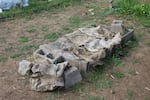
A garden plot covered in burlap coffee bags.
John Sepulvado/OPB
“This plot right here is a little on the rough side,” Miller told me.
“This doesn’t look like a plot, it looks like a grave,” I said.
The plot – covered in burlap coffee bags – sat in a kind of no man’s land between a greenhouse and other, much prettier places of the garden.
“This soil here has been covered with coffee sacks,” Miller said. “Which is really good thing because it’s protecting the soil from the sun. Yes there are lots of ants.”
“I don’t do ants, man,” I said.
“They won’t harm you,” Miller told me. “They’re not gonna bite you. They’re just crawling around. And we’re going to be keeping them at arms length, i.e. – with tools.”
Right then, Miller got to work with a rake, and combed the plot to get weed roots and rocks out.
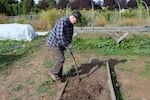
Miller got to work with a rake, and combed the plot to get weed roots and rocks out.
John Sepulvado/OPB
Then Miller put agriculture lime on the plot.
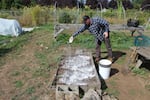
Putting agriculture lime on a garden plot.
John Sepulvado/OPB
I had no idea the soil in the Pacific Northwest was acidic. I had even less idea that plants love soil that’s pH balanced, and that agricultural lime helps.
I also always thought plants processed carbon dioxide, and left the absorption of oxygen to animals. But Miller said it’s important to help create conduits for oxygen to get to plant roots. Essentially, in low light, like under the ground, plants use oxygen to help create sugars. So, Miller grabbed his rake and started tilling.
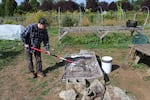
Tilling with a rake.
John Sepulvado/OPB
“Put it into the ground, step on it, and then just rock it back,” Miller said. “And then, as we open it up here, we see the soil is cracking. And what we’re doing here is introducing air into the soil, and also so that’s there’s plenty of oxygen there.”
After the soil was rake-tilled, we pulled weeds, cleared rocks and made little seed beds with the back handle of a garden knife.
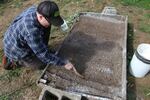
Making little seed beds with the back handle of a garden knife.
John Sepulvado/OPB
We planted Rapini on two thirds of the plot. Miller told me it’s one of the few edible plants we could grow, along with spinach and pineapple.
Just kidding.
I wanted to grow pineapple. Miller rolled his eyes and explained how outside growing and climate work. I'll spare you all the details, but if you want to try growing indoor pineapple, I'll refer you here.
Anyhow – in the rest of the plot we pulled crimson clover seed from a bucket and threw it on top of the soil.
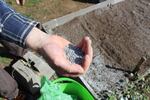
Pulling crimson clover seed from a bucket to throw on top of soil.
John Sepulvado/OPB
“The crimson clover is a leguminous cover crop,” Miller said. “Meaning it’s related to beans and things like that.”
Legumes carry bacteria for the soil that make it an ideal cover crop. Miller gently lays down a handful on the soil. When it’s my turn, I rain seed upon the soil, covering the ground in crimson clover.
“Well, we over-seeded a bit,” Miller said.
“I am an overachiever, Weston,” I retorted.
Weston Miller rolled his eyes and walked towards a garden hose. He brought it back over, turned it on, and pointed the nozzle to the sky.
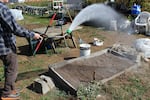
Weston Miller with a garden hose.
John Sepulvado/OPB
“The water is going to fall as if it is raining,” Miller said. “And the idea is we want to keep it moving. We don’t want it to puddle as much as it has right over there.”
A big puddle had formed in the corner of the plot. Miller turned off the hose and waited for it to drain, before starting the water again.
After we were watered, we put a wire frame and put a white fabric over the frame Miller put bricks over the fabric to hold it.
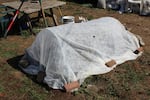
A wire frame with white fabric over the frame.
John Sepulvado/OPB
An hour had gone by. The plot was completely transformed. My fingernails were dirty, my hands were dry from soil, my new shoes were ruined.
I was in heaven.
We made our way to the parking lot, discussing our next meeting. Before I left, Miller gave me one more piece of advice: Gardening is all about timing.
“And you were late today – so, for next time, please, please, please, show up on time,” he said.
